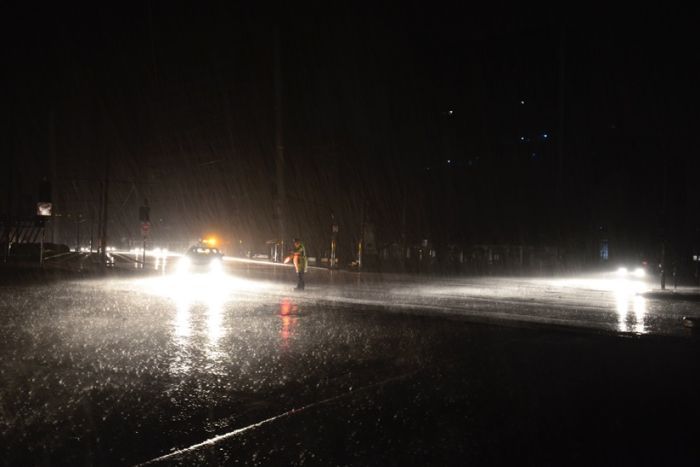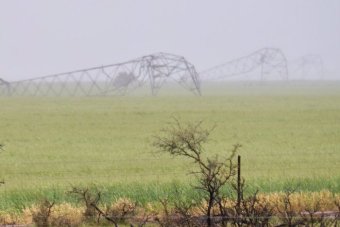A case of history repeating itself: What is wrong with South Australia's electricity network?
Posted
 Photo:
A lone policeman directs traffic in Adelaide's CBD during a statewide blackout in September. (ABC News: Tony Hill)
Photo:
A lone policeman directs traffic in Adelaide's CBD during a statewide blackout in September. (ABC News: Tony Hill)
Those who blamed last week's blackout in South Australia on renewable energy are dead wrong. But that does not mean the state's renewable-heavy power mix is not posing problems.
Consider this scenario: Hundreds of thousands of homes and businesses across SA are left without power after a major interconnector fails; industrial employers sound a warning; opposition parties blame a state government for a lack of forethought in energy policy design.
Sound familiar?
The event just described did not take place last week but was instead a widespread blackout that struck SA on December 2, 1999, well before the state became a world leader in intermittent renewable energy generation.
So what prompted history to repeat itself with another significant blackout last week? And why are renewable energy technologies in the firing line?
What caused last week's blackout?
As most of SA slept during the early hours of Thursday morning, an electrical fault on the Victorian side of the border prompted the failure of the Heywood Interconnector, separating SA from the national grid.
The bulk of the state's 1400 megawatt electricity demand was being provided by gas generators at the time, with only about 100 MW delivered by wind farms. There was no solar output because it was the middle of the night.
The Heywood Interconnector from Victoria was contributing about 220 MW of power into SA's mix. The interconnector is capable of importing almost three times that amount, but was constrained on the night in question due to maintenance.
The sudden loss of 220 MW of power is a major challenge for any electricity network. An unexpected change in supply must be met with a sudden change in demand. Because generators are unable to react quickly enough to produce more power, regulators have a system of emergency load shedding — switching off the power to customers to bring the system back into balance.
Thursday's event resulted in about 200,000 customers being blacked out.
The market operator also issued a directive to one of the state's biggest energy users, BHP Billiton, to restrict supply to its Olympic Dam mine in the state's far north.
Over the next few hours, gas generators within SA gradually increased their output and customers were reconnected.
The interconnector was reopened at 5:11am, about four hours after it was severed.
 Video: A 1999 ABC News story about power shortages in South Australia tells a familiar tale with familiar faces.
(ABC News)
Video: A 1999 ABC News story about power shortages in South Australia tells a familiar tale with familiar faces.
(ABC News)
How often does the interconnector fail?
Fortunately, very rarely. A report from the Australian Energy Market Operator showed Thursday's event was the sixth significant failure since 1999's major blackout.
Unfortunately for SA, two of those failures occurred within the past two months.
This includes a cascade of events during a major storm on September 28 that knocked out the interconnector and resulted in a devastating statewide blackout.
More on that in a minute.
Why is SA so reliant on the interconnector to Victoria?
Unlike New South Wales and Victoria, which have multiple points of interconnection, SA is hooked into the rest of the national grid via Victoria alone.
Energy is dispatched into the national electricity market in order of price from the cheapest generator to the most expensive. This is known in power circles as the merit order.
Because wind and solar energy are effectively free resources, and because their production is subsidised by governments, intermittent renewables are the first form of energy dispatched when available.
In the absence of a price on carbon, brown coal is the next cheapest form of power.
Since Victoria has a lot of this (until the Hazelwood power station closes down), the state is a net exporter of electricity into SA.
Since the closure of the Port Augusta power stations, SA's baseload generators are mostly gas, the most expensive form of energy. They are the last to switch on when the state needs power.
When the sun is shining and the wind is blowing, renewables produce enough energy to power up to 45 per cent of SA's needs.
Because of the sheer scale of this renewable resource, backed up by cheap Victorian coal, there are some days where other forms of generation are barely needed in SA.
This has changed the fundamental economics of running a baseload power station within the state. The ageing coal-fired Port Augusta power stations closed because its owner, Alinta, could not make a buck.
The Pelican Point gas generator was mothballed for a time, and AGL almost decommissioned one of its two Torrens Island gas generators.
Replacing gas and coal with cheaper renewables is good, right?
Yes and no. The sun is not always shining and the wind does not always blow. When renewable energy is scarce, the price of power is set by just a few major generators operating in an uncertain environment, meaning consumers can end up paying through the nose.
There is also the question of supply security.
Traditionally, fluctuations in frequency across the power grid have been balanced by the presence of big, heavy spinning turbines that are an inherent part of gas, coal and hydro generators. In the current market, solar PV and wind generators do not generally provide the same inertia.
As its own traditional generators are gradually forced out of the market, SA has become increasingly reliant on this stability coming across the interconnector from Victoria. And when it fails, problems can arise.
Is SA's grid less stable because of renewables?
Yes, but only on days when the interconnector fails and few of the state's big gas generators are running.
That was the case on the day of the September 28 statewide blackout. While the cause is still under investigation, the system was unable to cope with a massive frequency fluctuation that occurred when the interconnector failed.
In the wake of that catastrophe, the SA Government issued new regulations requiring better management of frequency within SA. This effectively means more gas generators remain fired up more often.
There was plenty of gas online when last week's interconnector failure occurred. Despite the widespread load shedding, the system coped and the grid remained online.
What is the solution?
SA urgently has to find a way to ensure that it not only has enough power, but that power is affordable and reliable.
 Photo:
Transmission towers were downed by a cluster of tornados that hit the state's Mid North during September. (ABC News: Tom Fedorowytsch)
Photo:
Transmission towers were downed by a cluster of tornados that hit the state's Mid North during September. (ABC News: Tom Fedorowytsch)
An investigation has already begun into the prospect of a new interconnector with NSW. But construction, if it happens, is still years away.
Some are advocating for a change in the way power is priced — to reward generators not just for the electricity they produce, but for their capacity to provide power when needed.
Such a measure would benefit baseload providers as well as the proponents of new storage technologies.
Governments are looking at ways to incentivise investment in new generators that have baseload characteristics. The SA Government and Independent Senator Nick Xenophon have been advocating for the adoption of a price on carbon in the electricity sector, a so-called Energy Intensity Scheme.
Such a scheme would see the oldest and most heavily polluting coal generators penalised in favour of gas or other generators who emit below a certain baseline.
On Monday, Federal Energy and Environment Minister Josh Frydenberg signalled for the first time that the Federal Government might be open to such a scheme.
Things might become clearer on Friday when Australia's Chief Scientist Alan Finkel briefs the Prime Minister, Premiers and Chief Ministers on how he thinks the national electricity market should be reformed.
There is plenty to consider. The constant hikes in power prices, coupled with falling costs of battery storage, are likely to prompt more and more Australians to give up on the grid altogether.
In the short term, that could make an already vexed problem even tougher to solve.
Topics: electricity-energy-and-utilities, industry, states-and-territories, state-parliament, federal---state-issues, government-and-politics, weather, sa, adelaide-5000, australia











